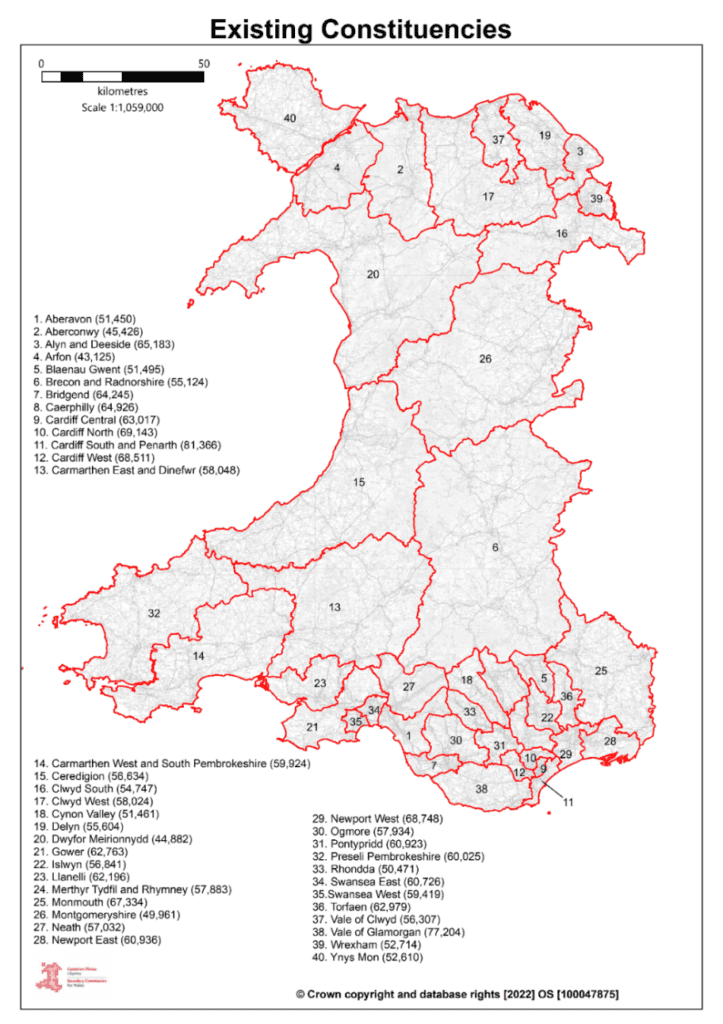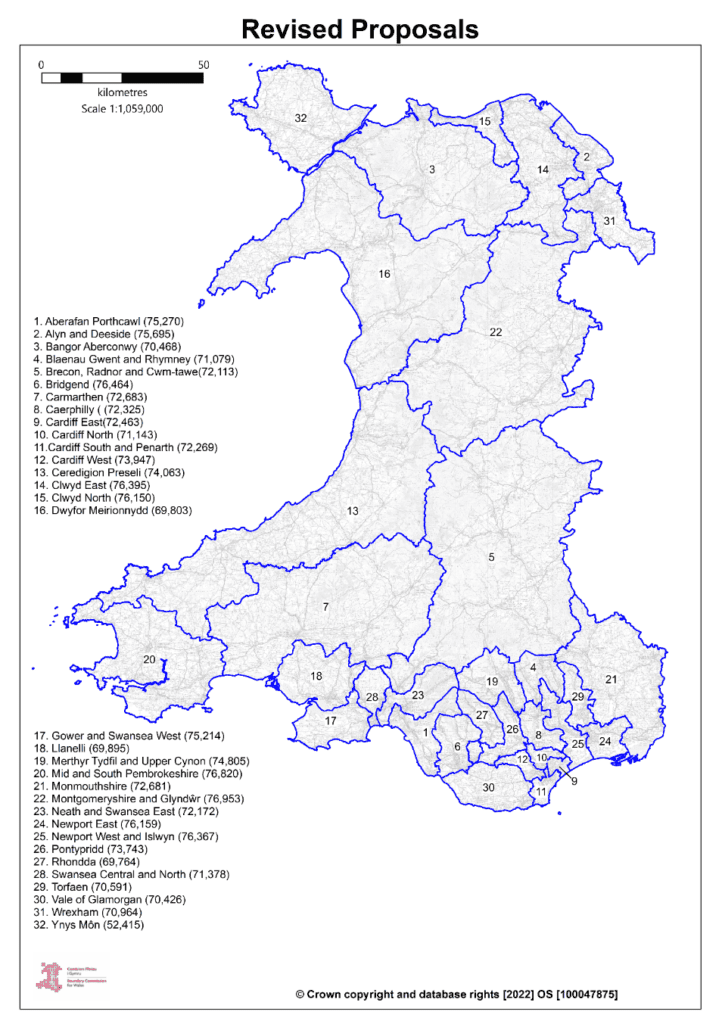The 2024 Welsh Constituency Boundary Changes
Background
Wales’ current Parliamentary constituency boundaries have been in use since the 2010 General Election and are therefore out of date. In March 2020, the government announced that it would restart the process of consulting on boundary changes, dropping the previous commitment to reduce the number of MPs to 600, as had been planned by David Cameron’s government.
The new boundary review stipulates that new constituencies must be nearly identical in terms of the number of electors in each seat; currently there is considerable divergence. For instance, according to the Office for National Statistics (ONS), the average electorate in Welsh constituencies is currently 57,700 compared to 73,000 in England, 68,300 in Scotland, and 74,100 in Northern Ireland.1
Inside Wales, there is also significant divergence between constituencies: presently, the constituency of Arfon is the smallest by population with an electorate of 43,125, whilst the largest is Cardiff South and Penarth with an electorate of 81,366 – a difference of over 38,000!
The 2023 Boundary Review requires new seats to be nearly identical. Aside from 5 specified exceptions (including Ynys Môn in Wales), every constituency must have an electorate that is no less than 95% and no more than 105% of the UK electoral quota (UKEQ) which, for the 2023 review, is 73,393. Consequently, the ‘statutory electoral range’ for each constituency is between 69,724 and 77,062. The new boundaries will be up for review every 8 years, as opposed to the current 5 years. The next Welsh review is thus due by October 2031.
Boundary Commission for Wales
In January 2021, the Boundary Commission for Wales announced the start of the 2023 review of Parliamentary constituencies in Wales, publishing its initial proposals in September 2021 and its revised proposals in October 2022 following two rounds of consultation.
In July 2023, the Commission will submit its final recommendations to the Speaker of the House of Commons which will result in the Secretary of State submitting the recommendations as a draft Order in Council to King Charles III, giving effect to the recommendations made.
After the Order in Council has been made, the new constituencies will take effect at the next general election, expected in spring or autumn 2024.
Since the 1997 General Election, Wales has had 40 parliamentary constituencies, and since the end of World War One, has not dropped below 35 seats. See below.2
| Year by Election | Number of seats |
| 1918-1945 | 35 |
| 1950-1979 | 36 |
| 1983-1992 | 38 |
| 1997-2019 | 40 |
| 2024 – | 32 |
The changes explained
Things will change in Wales for the 2024 election, with Welsh seats likely being reduced to 32. If the new boundaries had been in place in 2019, Labour would have won 19 seats, the Conservatives 11, and Plaid Cymru 2.
North Wales


At present, North Wales has 9 constituencies, stretching from Ynys Môn in the northwest to Clwyd South in the southeast. In the revised boundaries, the region will fall to 6 seats. The new Bangor Aberconwy constituency (3) will subsume Aberconwy, Clwyd West, and parts of Arfon, whilst the new Clwyd East constituency (14) will take the remnants of Clwyd West and Delyn. Wrexham (31) will expand geographically to take parts of Clwyd South, whilst Alyn and Deeside (2) will take the remainder of Delyn. The newly created Clwyd North (15) will take much of the Vale of Clwyd and parts of Clwyd West. Sections of Arfon are also being lost to West Wales.
Mid and West Wales


At present, Mid and West Wales has 7 constituencies, from Dwyfor Meirionnydd in the northwest to Brecon and Radnorshire in the southeast, to Preseli Pembrokeshire and Carmarthen West and South Pembrokeshire in the southwest. In the revised boundaries, the region will fall to 6 seats.
Dwyfor Meirionnydd (16) will largely remain the same, however it will subsume most of the soon-to-be-replaced Arfon seat. The new seat of Ceredigion Preseli (13) will replace the present Ceredigion and encompass much of Preseli Pembrokeshire and a small section of Carmarthen East and Dinefwr.
The remainder of Preseli Pembrokeshire and a large chunk of Carmarthen West and South Pembrokeshire will become the new seat of Mid and South Pembrokeshire (20). The newly created seat of Carmarthen (7) will be formed from half of Carmarthen West and South Pembrokeshire and the majority of Carmarthen East and Dinefwr. The revised constituency of Brecon, Radnor and Cwm-tawe (5) remains largely the same bar south-westerly expansion into the current seat of Neath. Finally, the new seat of Montgomeryshire and Glyndwr (22) remains similarly geographically positioned aside from the acquisition of land from Clwyd South.
South Wales


South Wales currently has 24 seats; it will have 21 if the proposed changes are enacted. Boundary changes are less pronounced in this region.
From east to west: Monmouthshire (21); Torfaen (29), and Newport East (24) remain largely the same, whilst the newly created Newport West and Islwyn (25) encompasses both Newport West and Islwyn. The new Blaenau Gwent and Rhymney (4) seat merges both Blaenau Gwent and Merthyr Tydfil & Rhymney. The new Merthyr Tydfil and Upper Cynon (19) takes land from Merthyr Tydfil & Rhymney and Cynon Valley as well as a small section of Islwyn. Caerphilly (8) takes land from the seat of the same name and a small section of Islwyn.
Onto the most southerly seats, Cardiff South and Penarth (11) retains the same name, gains a small section of the Vale of Glamorgan (30) – which is otherwise unchanged – and loses a small amount of land to Cardiff East (9) which retains similar boundaries. Cardiff North (10) likewise remains similar, with small expansion into Pontypridd. Cardiff West (12) and Pontypridd (26) both exchange small parcels of land and retain similar boundaries. Rhondda (27) retains much of its previous borders albeit with expansion into the current Pontypridd seat. The newly created Bridgend (6) takes land from the seat of the same name and gains territory from Ogmore. The new Bangor Aberconwy (3) (the unmarked shape between 6, 27, 26 and 30), takes land solely from Ogmore. The new Aberafan Porthcawl (1) encompasses land from Aberavon, Bridgend and small sections of Ogmore.
To the southwest, Neath and Swansea East (23) replaces both Neath and Swansea East respectively. Swansea Central and North (28) is created from a chunk of Gower and parts of Swansea West, whilst the new seat of Gower and Swansea West (17) takes the remainder of the two seats. The new boundaries of the Llanelli (18) constituency replaces a seat of the same name but gains land from the former Carmarthen East and Dinefwr.
Looking ahead to 2024
But how the new boundaries will affect each party’s respective representation?
It is important to note that this analysis considers current opinion polling which has demonstrated a consistent Labour lead of varying size and predicts how this lead would manifest in electoral terms.
Labour, unsurprisingly, look set to increase their seat tally in 2024, primarily at the expense of the Conservatives who will struggle to hold their current tally of 14 seats (including the independent MP for Delyn who was expelled from the Party). Plaid Cymru will start the election campaign with their seat total halved and little scope to make any gains. Labour do risk losing a handful of seats with small majorities, though should be able to comfortably offset any losses if they do occur.
The following table illustrates the seats most likely to flip at the next election.
| Current Seat(s) | New Seat | 2019 Result | 2024 Prediction |
| Marginal Conservative / Labour seats in last election | |||
| Aberconwy / Arfon / Clwyd West | Bangor Aberconwy (3) | Con Hold Plaid Cymru Hold – Con Hold | Labour-Conservative marginal – likely Labour gain |
| Vale of Clwyd | Clwyd North (15) | Con Gain | Labour gain |
| Wrexham | Wrexham (31) | Con Gain | Labour gain |
| Carmarthen East and Dinefwr / Carmarthen West and South Pembrokeshire | Carmarthen (7) | Plaid Cymru Hold Conservative Hold | Conservative – Plaid marginal |
| Vale of Glamorgan | Vale of Glamorgan (30) | Conservative Hold | Labour Gain |
| Newport East | Newport East (24) | Labour Hold | Labour Hold |
| Newport West | Newport West and Islwyn (25) | Labour Hold | Labour Hold |
| Alyn and Deeside | Alyn and Deeside (2) | Labour Hold | Labour-Conservative marginal – likely Labour hold |
| Ynys Môn | Ynys Môn (32) | Conservative Gain | Toss-up between Labour and Plaid |
| Conservative seats at risk in event of Labour double digit poll lead | |||
| Brecon and Radnorshire | Brecon, Radnor and Cmw-tawe (5) | Conservative Gain* | Conservative / Liberal Democrat marginal |
| Preseli Pembrokeshire / Carmarthen West and South Pembrokeshire | Mid and South Pembrokeshire (20) | Conservative Hold Conservative Hold | Conservative / Labour marginal |
| Monmouth | Monmouthshire (21) | Conservative Hold – 19.9% majority | Conservative / Labour marginal |
| Montgomeryshire | Montgomeryshire and Glyndwr (22) | Conservative Hold | Conservative Hold |
*Brecon and Radnorshire has been held by the Conservatives since 2015, aside from a four-month period in 2019 when the Liberal Democrats gained the seat in a by-election. This seat is thus vulnerable to tactical voting which is not reflected in uniform-swing polling.
The above predictions assume that the polls will tighten as election day draws closer, however, if Labour continue to retain a poll lead of 15 to 20 percent, then the Conservatives face the prospect of a wipe-out in Wales, potentially returning as little as 2 Welsh MPs to Westminster. This would represent the worst-case scenario for the Conservatives and would certainly paint a bleak picture on their performance across the country as a whole.3
Dr Jac Larner, lecturer in politics at Cardiff Universities Wales Governance Centre, concluded that the proposed boundary changes could make a Conservative wipe out ‘considerably more likely’, with both Montgomeryshire and Brecon and Radnorshire set to incorporate Labour-leaning areas within their new boundaries. Sir John Curtice, professor of politics at the University of Strathclyde, concurred, stating: ‘Labour’s lead over the Conservatives in today’s poll is bigger than in any YouGov poll conducted since David Cameron became Prime Minister in 2010. The party even has a commanding lead – by 41% to 31% – among those who voted Leave in the 2016 Brexit referendum.’4
Conclusion
The next election will mark a historic moment in Welsh elections, with the number of MPs returned from the nation falling from 40 to 32 – the lowest amount in over one hundred years.
Such volatility and profound change in the electoral calculus presents both opportunities and risks for each respective party, with gains and losses equally likely.
Overall, it appears likely that Labour will consolidate their hold over South Wales whilst making in-roads into North Wales, both at the expense of the Conservatives. Whether this is because of national shifts in popular support or because of alterations to electoral boundaries is up for debate – but it is likely a mixture of both.
Plaid Cymru’s best hope of a gain rests on Ynys Môn; whilst the Conservatives’ best chance of retaining seats resides in Mid and West Wales regionally, and Montgomeryshire & Glyndwr and Monmouthshire specifically.
Nevertheless, as Harold Wilson once said, ‘a week is a long time in politics’. With a likely eighteen months still to go until the UK goes to the polls, everything is still to play for.
Appendices
- Existing Welsh Parliamentary Constituencies

- Revised Welsh Parliamentary Constituencies
